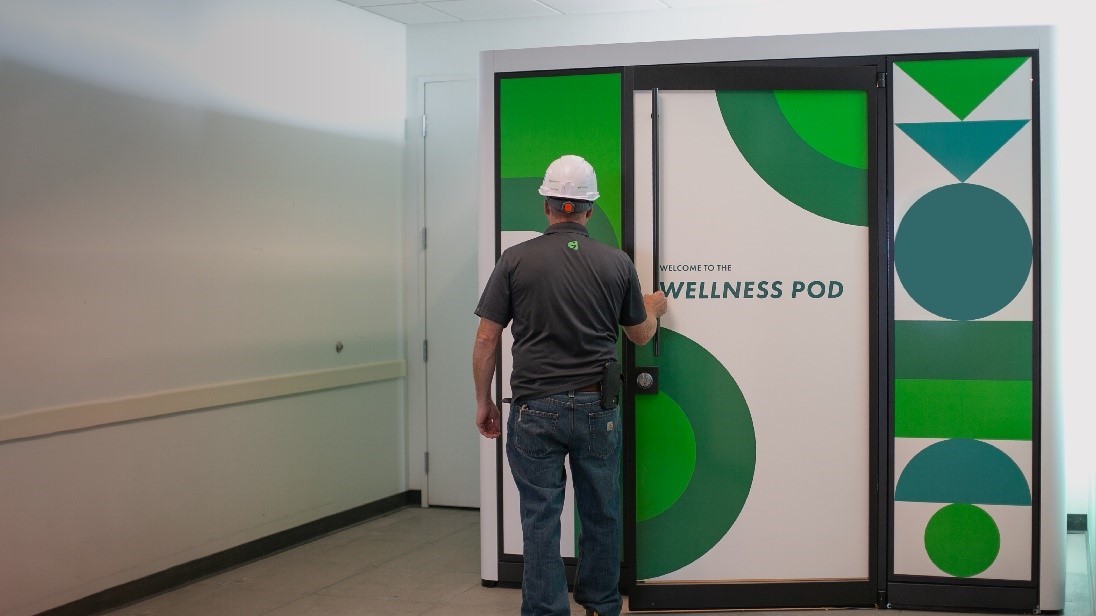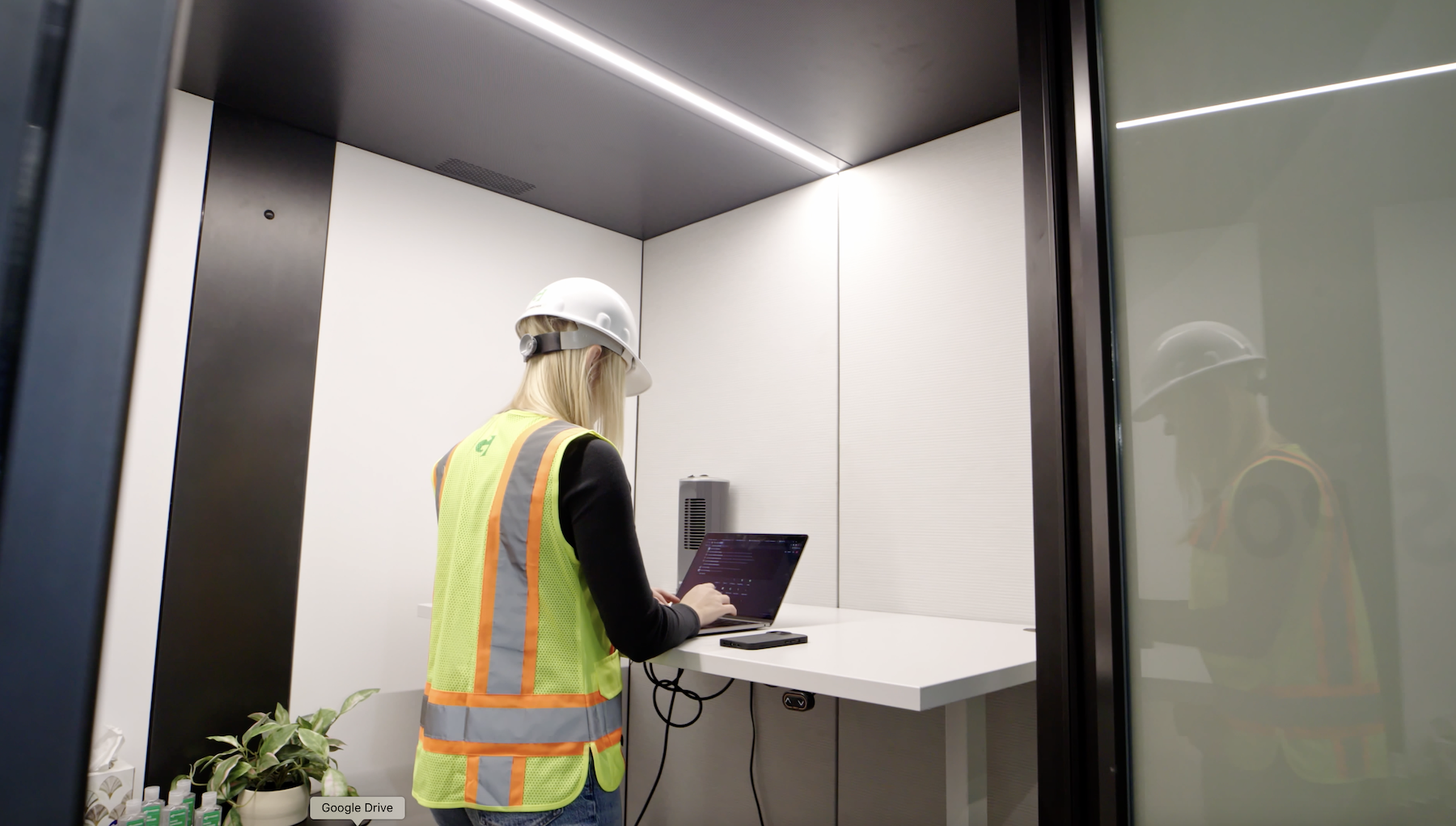The mental health of workers has emerged as an urgent topic within the construction industry, with firms considering the issue as part of their employee wellness initiatives.
One such firm is Minneapolis-based general contractor Gardner Builders. Three of its jobsites currently include Wellness Pods, 6x8-ft steel boxes that provide workers with a temporary, anxiety free sanctuary for private activities. The heated and cooled pods are wheelchair-accessible, with a mini fridge, desk and chair, and rug.
The concept for the pods dates back to last year, when Gardner Builders noticed that its employees engaged in activities that might be best served by having a private space to retire to. This need was expressed further during a meeting of the company’s internal Pulse group, which discusses employee concerns. A 20-year-old female laborer pointed out that she had nowhere to go while at work to pump breastmilk. “The idea for the wellness pod was borne from this,” says Jessica Stoe, Gardner Builders’ Brand, Wellness, and Marketing Director, and Wellness Pod Lead.
The first pods, built in May 2022, were small plywood boxes within Gardner’s offices. Stoe says the goal, then and now, was to create a place that is soundproof, comfortable, and accessible for everything from meditation, telehealth, privacy, and prayer. Based on worker feedback, most employees seem to be using the pods for private calls.
Future pods will be mobile

The pod is more of a concept than a static structure; some are on wheels, for example. Gardner has also partnered with the furniture supplier Teknion to develop its steel pod with a glass door. Stoe estimates that a plywood pod costs Gardner $3,000; the steel model runs between $12,000 and $16,000.
Right now, a jobsite’s foreman or superintendent handles the scheduling for using jobsite pods. Stoe says Gardner is looking into scheduling software similar to what office workers use to book meeting rooms.
Future iterations of the pods, says Stoe, are likely to be more mobile so they can be moved around a jobsite as needed. And Gardner is developing a ground-up, climate-controlled model for exterior use. That model, says Stoe, would have an iPad mounted to it that allows workers to schedule the pod themselves.
Gardner Builders has gotten inquiries about its Wellness Pods from the local YMCA and Chamber of Commerce, and wants to share the concept with other contracting firms.
Related Stories
| Jan 25, 2011
Top 10 rules of green project finance
Since the bottom fell out of the economy, finding investors and financial institutions willing to fund building projects—sustainable or otherwise—has been close to impossible. Real estate finance prognosticators, however, indicate that 2011 will be a year to buy back into the real estate market.
| Jan 25, 2011
Construction firms planning to hire, not fire in 2011, reports AGC
More construction firms are planning to hire workers this year than are planning to make layoffs, according to the results of an industry-wide survey by the Associated General Contractors of America and Navigant. The survey, conducted as part of the Construction Industry Hiring and Business Outlook, shows the industry may finally be emerging from a severe downturn that has left millions of skilled workers unemployed.
| Jan 25, 2011
AIA reports: Hotels, retail to lead U.S. construction recovery
U.S. nonresidential construction activity will decline this year but recover in 2012, led by hotel and retail sectors, according to a twice-yearly forecast by the American Institute of Architects. Overall nonresidential construction spending is expected to fall by 2% this year before rising by 5% in 2012, adjusted for inflation. The projected decline marks a deteriorating outlook compared to the prior survey in July 2010, when a 2011 recovery was expected.
| Jan 21, 2011
Combination credit union and USO center earns LEED Silver
After the Army announced plans to expand Fort Bliss, in Texas, by up to 30,000 troops, FirstLight Federal Credit Union contracted NewGround (as CM) to build a new 16,000-sf facility, allocating 6,000 sf for a USO center with an Internet café, gaming stations, and theater.
| Jan 21, 2011
Manufacturing plant transformed into LEED Platinum Clif Bar headquarters
Clif Bar & Co.’s new 115,000-sf headquarters in Emeryville, Calif., is one of the first buildings in the state to meet the 2008 California Building Energy Efficiency Standards. The structure has the largest smart solar array in North America, which will provide nearly all of its electrical energy needs.
| Jan 21, 2011
Primate research facility at Duke improves life for lemurs
Dozens of lemurs have new homes in two new facilities at the Duke Lemur Center in Raleigh, N.C. The Releasable Building connects to a 69-acre fenced forest for free-ranging lemurs, while the Semi-Releasable Building is for lemurs with limited-range privileges.
| Jan 21, 2011
Harlem facility combines social services with retail, office space
Harlem is one of the first neighborhoods in New York City to combine retail with assisted living. The six-story, 50,000-sf building provides assisted living for residents with disabilities and a nonprofit group offering services to minority groups, plus retail and office space.
| Jan 21, 2011
Nothing dinky about these residences for Golden Gophers
The Sydney Hall Student Apartments combines 125 student residences with 15,000 sf of retail space in the University of Minnesota’s historic Dinkytown neighborhood, in Minneapolis.
| Jan 21, 2011
Revamped hotel-turned-condominium building holds on to historic style
The historic 89,000-sf Hotel Stowell in Los Angeles was reincarnated as the El Dorado, a 65-unit loft condominium building with retail and restaurant space. Rockefeller Partners Architects, El Segundo, Calif., aimed to preserve the building’s Gothic-Art Nouveau combination style while updating it for modern living.
| Jan 21, 2011
Sustainable history center exhibits Fort Ticonderoga’s storied past
Fort Ticonderoga, in Ticonderoga, N.Y., along Lake Champlain, dates to 1755 and was the site of battles in the French and Indian War and the American Revolution. The new $20.8 million, 15,000-sf Deborah Clarke Mars Education Center pays homage to the French magasin du Roi (the King’s warehouse) at the fort.













